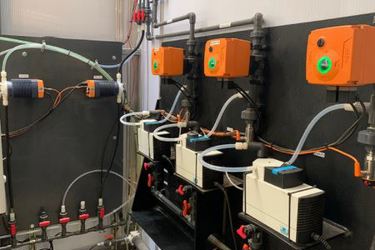Advantages Of Membrane Cell Hypochlorite Generators Over Open Cell System Technology
By Michael Warady

In an era where waterborne pathogens are evolving and regulatory standards are tightening, the role of supplementary disinfection in water treatment for municipal operators and industrial facility engineers has never been more crucial.
As the demand for solutions has increased, so too have the options available to operators in municipal and industrial environments. For many, a skid-mounted hypochlorite generator offers a nimble solution that can both ensure a continued disinfectant residual and security that system health remains strong. The choice of hypochlorite generator, whether open cell or membrane cell type, plays a pivotal role in determining operational efficiency and cost-effectiveness. While both are designed to sanitize and disinfect, these two families of technology exhibit distinct technical characteristics and operational advantages that will serve to shape the operator’s water treatment program throughout the life of the system.
Open cell systems have enjoyed widespread adoption over the past two decades due to their lower initial capital expenditure (CAPEX) cost. These systems typically produce sodium hypochlorite at a concentration of 0.8% w/w and feature numerous electrodes submerged in cylindrical chambers. However, despite their prevalence, open cell systems face notable challenges.
Volume of salt consumption poses a significant concern in open cell systems, often exceeding 3 kg per kg of chlorine produced. This high demand for salt not only escalates operational costs but also necessitates frequent replenishment, contributing to maintenance overhead and the risk of operational upset in the case of any supply chain issues, as we have seen frequently over the last three years. Additionally, the energy consumption of open cell systems, averaging around 4.4 kWh per kg of chlorine, presents efficiency hurdles that oftentimes overshadow the benefits of these systems due to the need for more energy efficient water treatment operations.
Moreover, the low concentration of sodium hypochlorite generated by open cell systems necessitates the use of oversized metering pumps for dosing (increased cost, increased maintenance), regular acid cleaning to remove scaling further complicates maintenance efforts, and the requirement for a hydrogen venting system adds to safety considerations for many operators.
In contrast, membrane cell systems serve as a trusted offering to protect human health and the environment using hypochlorite disinfection that offers compelling advantages as compared to open cell systems.
One of the primary advantages of membrane cell systems, and likely the most important factor in any water treatment system — is the ability to generate its final product (sodium hypochlorite) at a significantly higher concentration — 7.0% w/w — with a decreased lifecycle cost. The concentration of membrane cell systems aligns closely with the standard bleach concentration one can purchase from bulk suppliers, reducing storage space requirements and simplifying handling procedures.
Furthermore, membrane cell systems exhibit lower salt consumption, averaging around half that of open cell systems, around 1.85 kg per kg of chlorine produced. This reduced demand for salt not only lowers operational costs but also extends the interval between salt replenishments, streamlining maintenance activities.
Membrane cell systems also enjoy greater energy efficiency, consuming approximately 3.8 kWh per kg of chlorine produced. This energy efficiency translates into near term cost savings and environmental benefits, contributing to municipal and industrial goals that balance cost and energy savings.
The elimination of acid cleaning requirements in membrane cell systems represents a significant advancement in maintenance protocols. Without the need for regular cleaning to address scaling issues, membrane cell systems offer enhanced reliability and operational continuity. The absence of a hydrogen venting system in membrane cell systems simplifies safety considerations, eliminating the need for additional infrastructure and precautions. Finally, the higher concentration of sodium hypochlorite produced by membrane cell systems enables the use of smaller metering pumps, optimizing dosing processes and reducing equipment costs.
In conclusion, while open cell systems may offer lower initial CAPEX, membrane cell systems present compelling advantages that justify the investment. From higher sodium hypochlorite concentration and lower salt consumption to enhanced energy efficiency and simplified maintenance, membrane cell hypochlorite generators emerge as preferred solutions for industries and municipalities prioritizing efficiency and cost-effectiveness in water treatment. As technological advancements continue to drive innovation in membrane cell technology, the adoption of these systems is poised to revolutionize the water treatment landscape, paving the way for enhanced disinfection processes and sustainable water management practices.
Michael Warady is the CEO of EAI Water (www.eaiwater.com), based out of Walnut, CA. EAI, founded in 1986, is the leading industrial water treatment based in the Western United States and supports clients with a total water approach — providing chemicals, equipment, and ongoing service for all deployments and applications.
